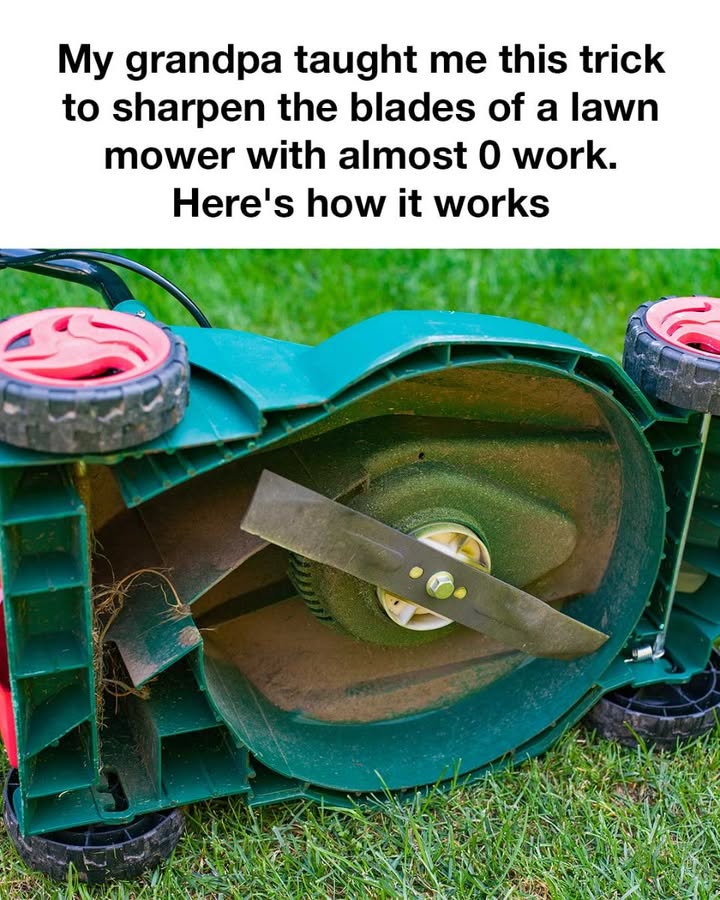Maintaining a healthy, lush lawn doesn’t just come from regular watering or fertilizer—it starts with the tool that does the cutting: your lawn mower. While many homeowners are quick to check oil levels or top off the fuel, there’s one critical maintenance step that’s often neglected—sharpening the mower blades. This small but essential task can make a world of difference in how your lawn looks and thrives. Dull blades don’t just affect performance—they actually damage your grass by tearing it instead of giving it a clean slice. This causes brown tips, invites pests, and makes your grass more vulnerable to disease. Luckily, I picked up an incredible tip from my grandpa, a tried-and-true hack that’s been passed down in our family for generations. It’s simple, effective, and best of all—anyone can do it without fancy tools or experience.

Let’s talk about why blade sharpness matters in the first place. Sharp blades are essential for a clean, even cut. They slice through grass blades effortlessly, creating a uniform, professional-looking lawn. On the flip side, dull blades leave behind jagged, frayed ends, causing grass to lose moisture faster and become more susceptible to damage. If you’ve ever wondered why your yard still looks scruffy after a fresh mow, dull blades might be the hidden culprit.
Now, about that family secret. My grandpa, who always had the greenest lawn in the neighborhood, swore by a low-effort method that doesn’t require grinders, files, or a trip to the shop. It all comes down to using sandpaper—yes, regular sandpaper—and a little elbow grease. His approach skips the expensive gadgets and keeps things basic yet effective.
Here’s what you’ll need to follow his method: a strip of fine-to-medium grit sandpaper, a can of WD-40 or a similar lubricant, a socket wrench that fits your mower’s blade bolt, a wooden block, and protective gloves. Once you’ve got your tools ready, the process is surprisingly straightforward and quick—perfect for a weekend tune-up.
Start by tipping your lawn mower on its side. Make sure the air filter and carburetor are facing up to avoid spilling any fuel. Once the mower is steady, grab your socket wrench and carefully remove the blade. This part is crucial, so take your time and wear gloves to avoid accidental cuts. After removing the blade, spray a bit of WD-40 onto your sandpaper. Place the sandpaper on the wooden block, creating a stable surface to work on. Then, slowly and gently drag the blade across the sandpaper, repeating until you achieve a sharp, even edge. Reattach the blade using the socket wrench and make sure it’s fastened securely.
The whole process usually takes around 15 minutes and can make a dramatic difference in how your mower performs. But even though this trick is simple, safety should always be top of mind. Make sure your mower is completely off and disconnected from any power source before you begin. Always use gloves when handling the blade, and work in a well-lit, stable area to prevent slips or accidents.
Keeping your blades sharp doesn’t just improve your lawn’s appearance—it also protects your mower’s engine. A dull blade forces the motor to work harder, burning more fuel and wearing out faster. By reducing that strain, you extend your mower’s lifespan and get a cleaner, more energy-efficient cut. Plus, your lawn will thank you for it by growing back thicker, greener, and more resistant to drought, pests, and foot traffic.
Of course, there are alternative ways to sharpen blades, including using bench grinders, sharpening stones, or professional services. While these methods work, they often require more time, money, or technical know-how. That’s why my grandpa’s method stands out—it’s accessible, inexpensive, and easy enough for any homeowner to handle.
Just be careful not to overdo it. Over-sharpening a blade can thin it out too much, making it prone to chips and early wear. It’s also important to check the blade’s balance before reinstalling it. An unbalanced blade can cause annoying vibrations and even damage your mower’s motor over time. As a final step, always clean the blade and mower deck before reassembly to prevent rust and ensure a smoother performance.
In the end, a well-maintained mower is the foundation of a well-kept lawn. With just a few simple tools and a bit of time, you can make a huge difference in the health and look of your yard. Thanks to my grandpa’s timeless trick, blade sharpening is no longer a chore—it’s a quick, satisfying part of the lawn care routine. So the next time your grass looks uneven or your mower seems sluggish, give this method a shot. You might be surprised at just how much better your lawn looks after one sharp upgrade.





